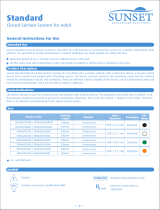
9
3.4. Fixation
If deemed necessary, secure AuraGain to the patient’s
face with adhesive tape or with a mechanical tube holder
suited for this purpose. 7 It is recommended to use a
gauze bite block.
3.5. Inflation
• Without holding the tube, inflate the cuff with just
enough air to obtain a seal, equivalent to intracuff
pressures of a maximum of 60 cmH
2
O.
6
Often only half
of the maximum volume is sufficient to achieve a seal –
please refer to Table 1 for maximum intracuff volumes.
• Monitor the cuff pressure continuously during the
surgical procedure with a cuff pressure gauge. This is
especially important during prolonged use or when
nitrous oxide gases are used.
• Look for the following signs of correct placement:
The possible slight outward movement of the tube
upon cuff inflation, the presence of a smooth oval
swelling in the neck around the thyroid and cricoid
area, or no cuff visible in the oral cavity.
• The mask may leak slightly for the first three or four
breaths before settling into position in the pharynx. In
case leakage persists, check that there is adequate
depth of anesthesia and that the pulmonary inflation
pressures are low before assuming that reinsertion of
AuraGain is necessary.
3.6. Verification of correct position
• Correct placement should produce a leak-free seal
against the glottis with the tip of the cuff at the upper
oesophageal sphincter.
• The vertical line on the patient tube should be oriented
anteriorly towards the patient’s nose.
• AuraGain is inserted correctly when the patient’s
incisors are between the two horizontal lines on the
patient tube. 2, item 5. Reposition the mask if the
patient’s incisors are outside this range.
• The position of AuraGain can be assessed by
capnography, by observation of changes in tidal
volume (e.g., a reduction in expired tidal volume), by
auscultating bilateral breath sounds and an absence of
sounds over the epigastrium and/or by observing chest
rise with ventilation. If you suspect that AuraGain has
been positioned incorrectly, remove and reinsert – and
ensure that anesthetic depth is adequate.
• Visual confirmation of anatomically correct position is
recommended, e.g., by using a flexible scope.
UNEXPECTED REGURGITATION:
• Regurgitation may be caused by inadequate level of
anesthesia. The first signs of regurgitation may be
spontaneous breathing, coughing or breath-holding.
• If regurgitation occurs, if oxygen saturation remains at
acceptable levels, AuraGain should not be removed.
This should be managed by putting the patient in a
“head-down” position. Briefly disconnect the anesthetic
circuit so that the gastric contents are not forced into
the lungs. Check that anesthetic depth is adequate and
deepen anesthesia intravenously, if appropriate.
• Apply suction through the mask’s patient tube and
through the mouth. Suction the tracheobronchial tree
and inspect the bronchia using a flexible scope.
• If regurgitation is anticipated, it is recommended that a
gastric tube is passed through the gastric channel of
AuraGain into the patient’s stomach.
3.7. Usage with other devices/equipment
ANESTHETIC SYSTEM AND VENTILATION BAG
The mask can be used for either spontaneous or
controlled ventilation.
During anesthesia, nitrous oxide may diffuse into the cuff
causing an increase in cuff volume/pressure. Adjust cuff
pressure just enough to obtain an adequate seal (cuff
pressure should not exceed 60 cmH2O).
The anesthetic breathing system must be adequately
supported when connected to AuraGain to avoid rotation
of the mask.
USAGE WITH SPONTANEOUS VENTILATION
AuraGain is suitable for spontaneously breathing patients
when used with volatile agents or intravenous anesthesia
on condition that anesthesia is adequate to match the level
of surgical stimulus and the cuff is not overinflated.
USAGE WITH POSITIVE PRESSURE VENTILATION
When applying positive pressure ventilation, ensure that
the seal is adequate. To improve the seal the following
is suggested:
• Optimize placement of AuraGain by head turning
or traction.
•Adjust the cuff pressure. Try both lower and higher
pressures (a poor cuff seal may be caused by either too
low or too high cuff pressure).
•If leakage should occur around the cuff, remove the
mask and reinsert while ensuring that anesthetic depth
is adequate.














